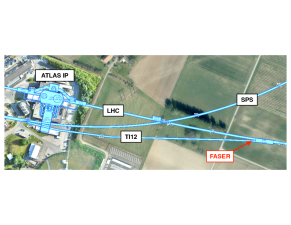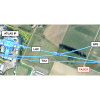FASER – new LHC experiment with strong Polish accent
2019.03.06 18:09 - Marek PawłowskiAnother experiment by the Large Hadron Collider (LHC) will be built in CERN. One of its originators is Polish, Dr Sebastian Trojanowski from NCBJ Theoretical Physics Division. FASER – as the new installation is to be called – will be a multidetector designed to search for long-lived particles that are produced during collisions in LHC and which can be a signal of existence of the hypothetical dark matter. Astronomical observations suggest, that the amount of dark matter in the Universe should be a few times larger than regular „atomic” matter - that people, planets and stars are made up of.
The concept of FASER experiment has been proposed by Dr Sebastian Trojanowski and three other theoretical physicists that cooperated with him during Dr Trojanowski’s internship in University of California, Irvine under programme Mobility Plus funded by Ministry of Science and Higher Education. The experiment will search for new, so far undiscovered particles which can be produced in proton collisions, for example in the collision point in ATLAS detector. Scientists predict, that these can indeed exist, but were not detected so far because of their weak interaction with detector’s matter. „Such particles – of they are sufficiently light, if they are produced quite rarely and moreover, they fly along the axis of proton beams, then they could slip experimenters’ eyes.” – explains Dr Trojanowskki (NCBJ; currently on doctoral internship in University of Sheffield). „It would be hard to see them as, for example, significant signal of missing energy in energy balance of collision’s products. A chance of their possible detection is placing the detector at a certain distance from the production point and trying to register the predicted decay products. A condition, which must be met in order for this scenario to work is that the mass of the sought particles must be larger than the combined mass of the lightest products of the possible decay – for example electron-positron pair”.
The proposed FASER experiment, recently approved by CERN, is to be located approx. half a kilometre from the ATLAS detector in a service tunnel of LHC. The system will be composed of scintillators, magnets, drift chambers and a calorimeter, which measures the energy of products, if the decay really happens. „The whole system is a few metres long and is partially composed of spare parts from other functioning LHC experiments” – explains Dr Trojanowski. „The biggest investment will be ordering suitable magnets in CERN. Most of the costs will be covered by two American foundations: Simons and Heising-Simons”.
Currently over 20 scientists – not counting the four originators – from Switzerland, USA and other countries are engaged in the project. The schedule accepted by CERN predicts, that installation work will be carried out during the next big intermission in the LHC work schedule and data collection will start in the LHC research cycle planned for year 2021–2023.
For years scientists have been searching for new, undiscovered forms of matter. Astronomic observations provide arguments that are difficult to challenge. According to them, in the Universe there is an unknown matter, which interacts mainly gravitationally with the building blocks of „regular” matter- atoms. Even though the calculations point out, that the amount of this undiscovered „dark” matter is a few times greater than the amount of „normal” matter in the Universe, so far we have not been able to produce it or observe its components in our laboratories. The proposed experiment is one of many propositions inspired by this mystery. Particles, which FASER will be searching for, could be the first element on our way to solving it. The possible negative results will also expand our knowledge and rule out certain theoretical concepts.


















